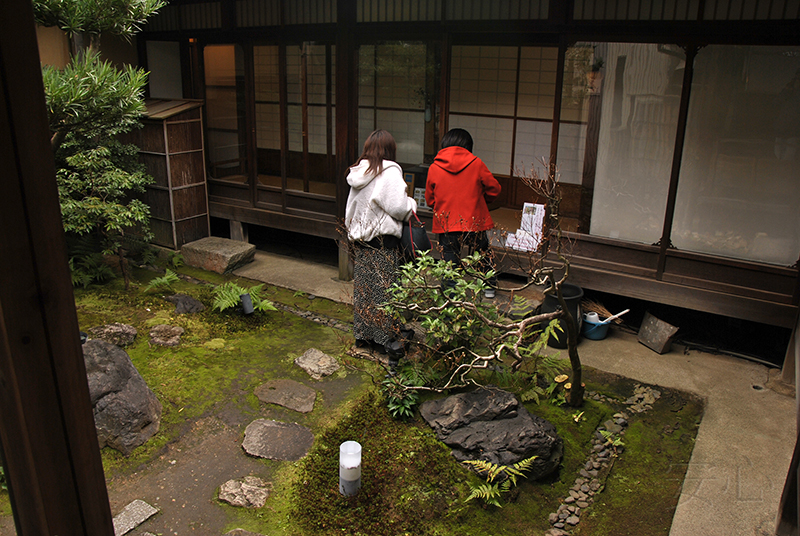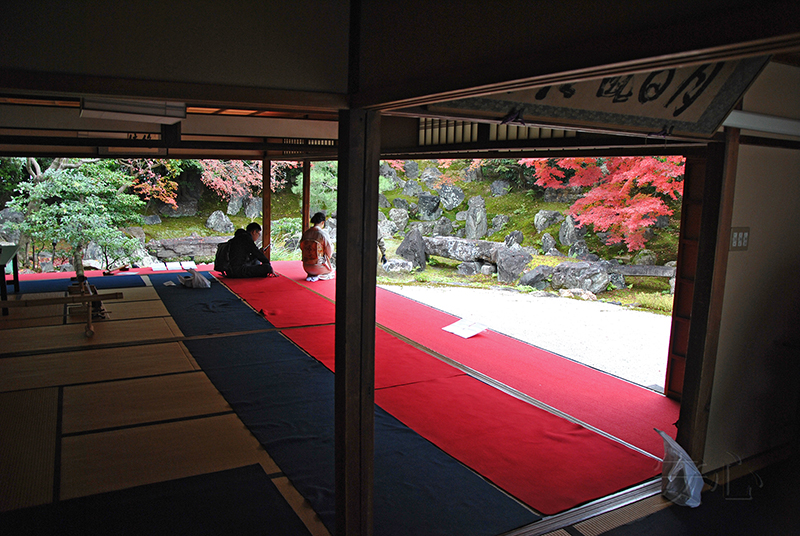
Entoku-in Temple gardens, Kyoto
Entoku-in Temple was founded in 1605 by Toyotomi Hideyoshi's widow, Nene. Then it was given the name Kodai-in. After the death of her husband, Nene became a nun and spent the rest of her life here, to carry out prayers for his soul. She also transferred one of the buildings of Fushimi Castle, along with the northern garden, to the temple, as it was especially dear to her as a memory of her husband. After her death, Nene's nephew founded the Entoku-in temple.
As in most temples of that time, there are two gates through which you need to go. Paved paths, well-groomed area around. In autumn, magnificent red maples and flowering ligularia serve as decoration.
Ligularia in Japanese is "tsuwabuki" or "iwabuki". They say that Entoku-in Temple is also known as "Iwabuki Temple"and that Nene admired these flowers.
Then we got to the main hall (Hojo). Here is the South Garden. It is relatively young, having been created during the Showa era under the guidance of the renowned garden explorer Osamu Mori. The garden is maintained by a specialist, popular gardener Yasuo Kitayama. And, it should be noted, he has enough work here, as large maples grow around, so their foliage falls on fine gravel dumping.
The garden is a dry sea with raked waves. It is very unusual that we did not see a single island here. Only a winding coastline depicts peninsulas and bays. On the opposite side, huge stones are adjacent to small pebbles, evoking associations with a village located at the foot of the mountain.
The main hall has several rooms, walls and sliding partitions are decorated with images of pine trees, bamboo, cherry blossoms, snow, moon, flowers. The exhibition also features ink paintings by Hasegawa Tohaku, a prominent artist of the Azuchi-Momoyama period, which are nearly 400 years old.
Here you can also try your hand at calligraphy or drawing. We also noticed small boxes with white sand and stones on the tables. Apparently, those who wish can practice creating a rock garden.
Below is a photo of the painting "Winter Landscapes" by Tohaku Hasegawa. It is said that when an artist saw a fusuma (Japanese sliding door) with a white paulownia pattern, he compared it to snow and drew the design using the fusuma pattern. It is also believed that the painting depicts the landscape of his hometown of Nanao rather than Kyoto.
Then we went along the covered corridor connecting the Hojo and the northern shoin, meeting interesting courtyards along the way. You could even go down into this small tsubo. Pay attention, ligularia grow here too!
Or here is another garden, with a stone bowl on high legs.
At the end of the corridor is an earthen barn, the inscription on it means "a storage that never ends." It's kind of a metaphor: there's something here that never disappears, no matter how much you take. The inscription refers to a book by a Chinese author from the Song Dynasty, which says: “Even if I use the clear wind blowing over the Yangtze River or the bright moon in the mountains as a motive for my poem, they will never disappear. And you can do it too!”
At the end of the corridor is the shoin. Before entering you will be met by a fox in the form of a monk. This is a werewolf fox, fox Sotan. There is a legend that the grandson of Sen no Rikyu (one of the founders of the tea ceremony) Sotan once held a tea ceremony. After that, the students in the lobby stood and praised the master. At that moment, Sotan rushed through the door with the words: “Sorry, I'm late. Now let's go to the tearoom." The disciples were surprised, but again went to the ceremony. This happened several times, until one day Sotan arrived on time and found that someone was leading the ceremony in his guise. Turned out it was a werewolf fox. He apologized and was forgiven as he performed the ceremony very well.
After that, the fox began to dress up as a monk, beg for alms, play with the monks, and help the tofu seller across the street. One day, a mouse fell from the ceiling into a pot where tofu was being prepared. She was taken out and thrown out of the store. The smell of oil seduced the fox Sotan, he ate the mouse and at the same moment lost his supernatural abilities. Dogs chased after the fox, he fell into the well and drowned. And the saddened shopkeeper built a sanctuary for him.
Shoin is a kind of meditation hall overlooking the northern garden.
There are also many rooms, including for training.
The garden was moved here in 1605 from Fushimi Castle along with the hall. Interestingly, it was originally a garden with a pond. Its author is Kentei, a recognized master of stonework, a favorite student of Kobori Enshu. Subsequently, Enshu himself was engaged in moving the garden and installing stones in a new place. But he turned it into a garden with a dry pond.
The northern garden is shaped like a fan, what gives the viewer the optical illusion of greater depth and larger territory than it really is.
Stones are the main characters of this garden. There are about three hundred - four hundred of stones, half of them were donated to Hideyoshi by feudal lords from different places. They say that the names of the donors are engraved on the reverse side of each such stone, but, as you understand, it is not possible to verify this))
A dry waterfall flows down from an artificial hill.
There are three stone bridges here. The one on the far right is the longest one, huge boulders of different shapes are installed on both sides. And in the center is a small stone as a support. Behind this bridge, a sprawling maple tree grows, its branches hide the stone composition of Sanzon-seki (stones representing the three incarnations of the Buddha). Apparently, it is possible to see them well only after the foliage has completely fallen off.
In front of the left bridge is Turtle Island, and the bridge in the middle is a part of Crane Island. The hill behind it is the sacred mountain Horai.
Due to the panoramic view of the garden, it is very difficult to photograph it in its entirety. Therefore, I will separately add the extreme left part.
And right part. It can be seen both from the hall and from the exit.
In the western part of the northern garden, there is a tea house preserved from the Edo period. This tea room is three tatami-sized, where you need to crawl through a narrow entrance (nijiriguchi), where to stone steps lead.
Here you can drink matcha tea before the samurai tea ceremony designed by Furuta Oribe. Hideyoshi, who did not like Rikyu's wabi-cha ceremony, ordered to Oribe to create a samurai tea ceremony, not so strict and simple.
The tea room itself has no name, and its origin is unknown. It was moved here in the late Edo period. Nearby is a stone bowl. It is believed that it was originally a pagoda built during the Muromachi period, and then, around the time the garden was created, it was turned into a chozubachi.
However, tea ceremonies are held only on weekends. At other times, you can order tea and drink it in the hall, enjoying the view of the beautiful garden. Probably many years ago, Nene herself sat here, drinking tea and sadly recalling the days when she lived with her beloved Hideyoshi.
Garden Information:
Address: 530 Shimogawara-cho, Higashiyama-ku, Kyoto 605-0825, JAPAN
Opening hours: from 10 a.m. to 5 p.m.
anshin©2011All rights reserved. When using the materials of the site, reference is obligatory.
Proposals for co-operation, as well as comments and suggestions on the site please send to the address: anshinsad@gmail.comtel: +7 (965) 121-80-60, 10am-20pm


























